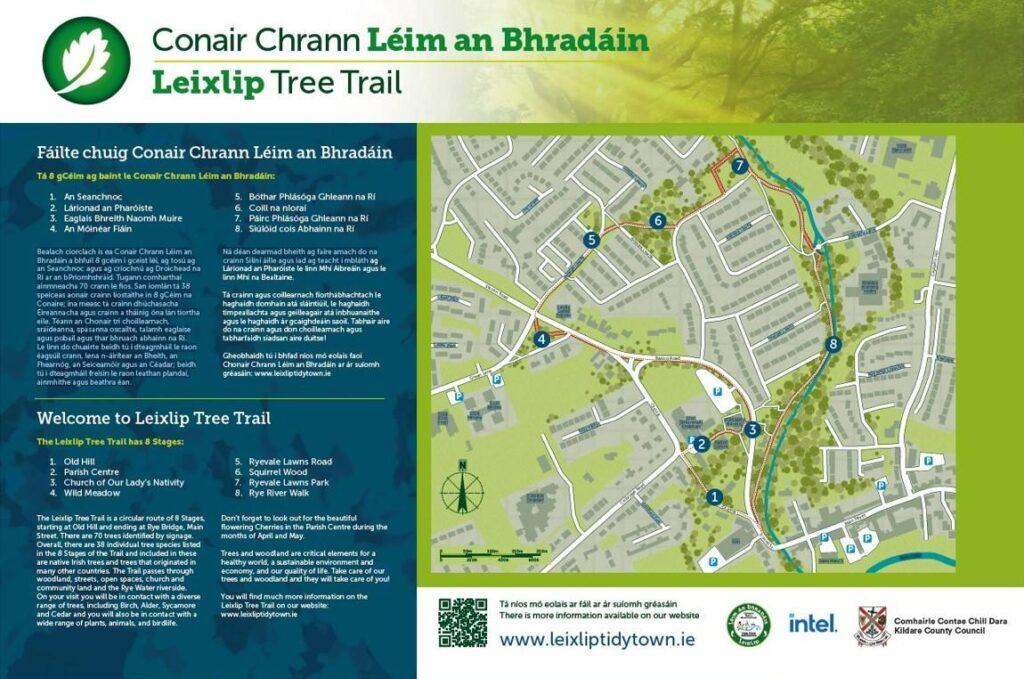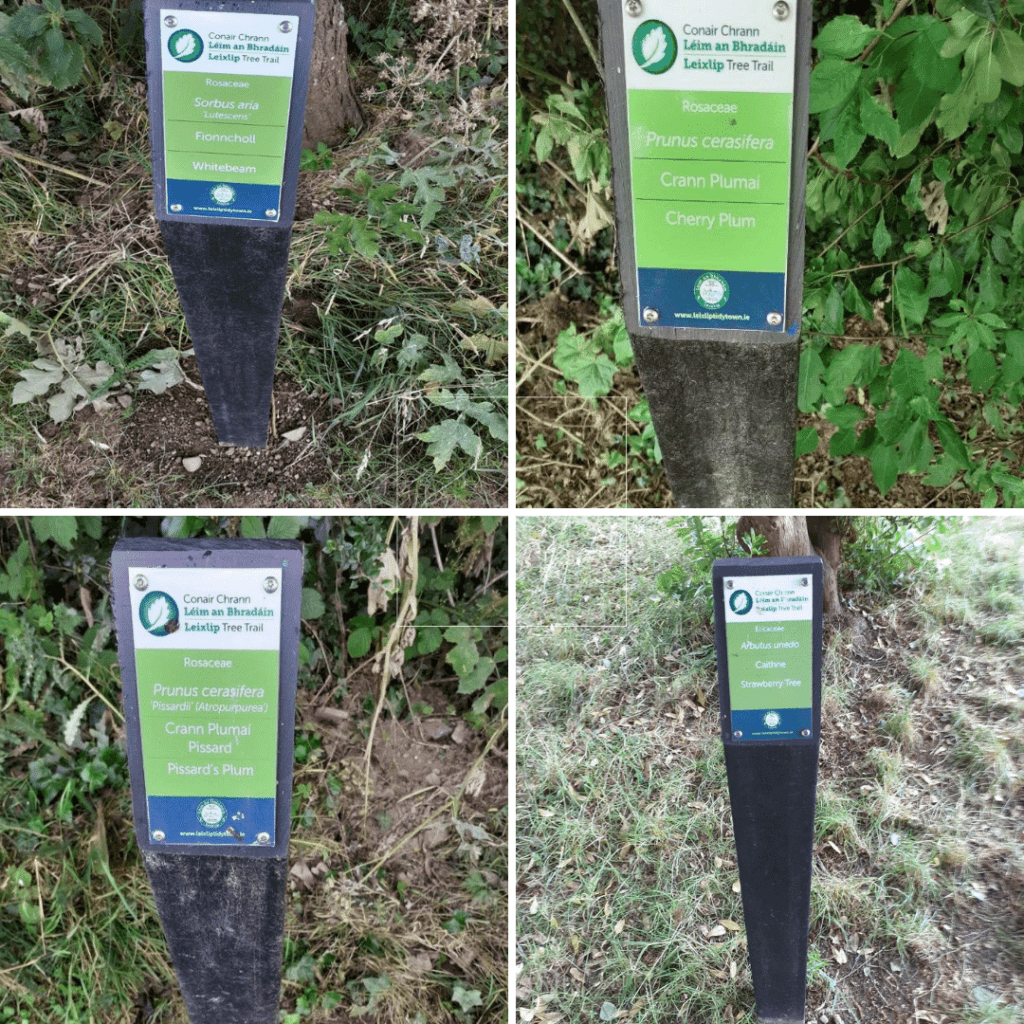Leixlip Tidy Town’s New Tree Trail
Introduction
Leixlip Main Street is too narrow to accommodate large mature trees such as found in many other towns and villages. This gives the erroneous impression that Leixlip is devoid of mature trees. Nothing could be further from the truth; in fact Leixlip has a rich tree heritage, some old and magnificent, some native, and some foreign and exotic. To illustrate and promote Leixlip’s tree heritage, Leixlip Tidy Town Association (LTTA) has developed a Tree Trail, a recognised method of generating interest in trees in local communities. The objective is to educate our community, particularly its younger members, on the vital role of trees in our daily lives. They sequester carbon thereby mitigating global warming, they contribute to biodiversity and they visually enhance the landscape. Initially, securing the necessary finance was an obstacle but an Intel Pride of Place award of €4,000 eased that problem.
Picture 1. During Covid, a socially distant presentation of the Intel cheque to Gerry Keane and Berni Brennan of LTTA

Planning the Tree Trail
A professional arborist was engaged to advise on planning the Trail and to oversee its development. The first task was to choose the route which was then marked on an enlarged Ordnance Survey map. The route was largely determined by four locations with a diversity of mature trees, namely the Church Grounds/Parish Centre, Wild Meadow, Squirrel Wood and Rye River Walk. Linking these were four other stages making for an 8 stage Trail in total. The Trail starts on Old Hill with a large Trail Head information panel (Picture 2) listing the 8 stages of the Trail together with a map of the Trail route The panel text is in both English and Irish.

Picture 2. Leixlip Tree Trail Information Panel
Developing the Tree Trail
Numbers and English Names
The number of trees together with their English or common names labelled at each location is shown in Table 1. In total, 71 trees are labelled. It is not best practice to affix labels to trees so labelling is by means of posts cemented into the ground beside the trees. These posts are made from recycled plastic and are long lasting. They are 1.5m in length of which 0.5m with a 25cm iron crossbar is inserted into the ground in quick–setting concrete. The top of the post which is 1.0m above ground is angled to accommodate the tree name plate. The name plate shows the Tree Family together with the name of the tree in English, Irish and Latin (Picture 3). The 71 labelled trees comprise of 38 different species / types and 13 different families
The below tables are best viewed on desktop/laptop
TABLE 1. STAGE, LOCATION AND COMMON NAME OF LEIXLIP TREE TRAIL TREES
| Order | Stage | Location | No.* | Common Name |
| 1 | 1 | Old Hill | 1 | Monterey Cypress |
| 2 | 2 | Common Beech | ||
| 3 | 2 | Parish Centre | 1 | Cherry Plum |
| 4 | 2 | Horse Chestnut | ||
| 5 | 3 | Whitebeam | ||
| 6 | 4 | Pissard’s Plum | ||
| 7 | 5 | Silver Birch | ||
| 8 | 3a | Church Grounds | 1 | Sycamore |
| 9 | 2 | Lawson Cypress / Port Orford Cedar | ||
| 10 | 3 | Small Leaved Lime | ||
| 11 | 4 | Yew | ||
| 12 | 3b | Station Road | 1 | Pissard’s Plum |
| 13 | 2 | Cherry Plum | ||
| 14 | 3 | Whitebeam | ||
| 15 | 4 | Wild Meadow | 1 | Mountain Ash or Rowan |
| 16 | 2 | Common Alder | ||
| 17 | 3 | Common Ash | ||
| 18 | 4 | Holly | ||
| 19 | 5 | Small Leaved Lime | ||
| 20 | 6 | Common Hornbeam | ||
| 21 | 7 | River Birch | ||
| 22 | 8 | Irish Oak | ||
| 23 | 9 | Pedunculate Oak | ||
| 24 | 10 | Field Maple | ||
| 25 | 11 | Strawberry Tree | ||
| 26 | 12 | Snowy Mespil | ||
| 27 | 13 | Downy Birch | ||
| 28 | 14 | Turkey Oak | ||
| 29 | 15 | Horse Chestnut | ||
| 30 | 16 | Common Beech | ||
| 31 | 17 | Silver Birch | ||
| 32 | 18 | Grey Alder | ||
| 33 | 19 | Himalayan Birch | ||
| 34 | 20 | Claret / Raywood Ash | ||
| 35 | 5 | Ryevale Road | 1 | Common Hornbeam – line of them |
| 36 | 2 | Silver Birch | ||
| 37 | 6 | Squirrel Wood | 1 | Common Elder |
| 38 | 1 | Mountain Ash or Rowan | ||
| 39 | 2 | Yew | ||
| 40 | 3 | Horse Chestnut | ||
| 41 | 4 | Horse Chestnut | ||
| 42 | 5 | Downy Birch | ||
| 43 | 6 | Common Ash | ||
| 44 | 7 | Aspen | ||
| 45 | 8 | Blue Atlas Cedar | ||
| 46 | 9 | Sycamore | ||
| 47 | 10 | Silver Birch | ||
| 48 | 11 | Hawthorn | ||
| 49 | 12 | Small Leaved Lime | ||
| 50 | 13 | Leyland Cypress – line of them | ||
| 51 | 7 | Ryevale Lawns Park | 1 | Mountain Ash or Rowan |
| 52 | 2 | Silver Birch | ||
| 53 | 3 | Wild Cherry or Gean | ||
| 54 | 4 | Silver Birch | ||
| 55 | 8 | Rye River Walk | 1 | Blackthorn |
| 56 | 2 | Common Ash | ||
| 57 | 3 | Hawthorn | ||
| 58 | 4 | Leyland Cypress ‘Silver Dust | ||
| 59 | 5 | Goat Willow | ||
| 60 | 6 | Field Maple | ||
| 61 | 7 | Horse Chestnut | ||
| 62 | 8 | Common Elder | ||
| 63 | 9 | Blackthorn | ||
| 64 | 10 | Common Elder | ||
| 65 | 11 | Hawthorn | ||
| 66 | 12 | Crack Willow | ||
| 67 | 13 | Common Ash | ||
| 68 | 14 | Hazel | ||
| 69 | 15 | Golden Weeping Willow | ||
| 70 | 16 | Sycamore | ||
| 71 | 17 | Wild Cherry or Gean | ||
| * Within Stage | ||||

Picture 3. Some of the Tree Name Posts
Common, Irish and Latin Names of Trees and Families
The common (or English), Latin and Irish names of the 38 different tree species / types labelled are shown in Table 2. The Latin version is the definitive tree name. In a small number of cases the label refers to a line of trees, e.g. the line of Hornbeams on Ryevale Road and the line of Leyland Cypresses along Ryevale House perimeter fence. The number of trees of each species in the Trail is shown in Table 2. Nineteen species have just one member, 10 have two, 6 have 3, and three have 4 or more members. Also shown in Table 2 are the tree families and the locations on the Trail of the different tree species. The 38 species /types in the Trail represent 13 different tree families. As with species, most families have only one or two members but two families, Betulaceae and Rosaceae, are unusually abundant with 17 and 18 members each.
TABLE 2 – COMMON NAME, LATIN NAME, IRISH NAME OF LEIXLIP TREE TRAIL TREES
| Common Name | Latin Name | Irish Name | No. of this Species | Tree Family | No of this Family | Where Found |
| Monterey Cypress | Cupressus macrocarpa | Cufróg Monyerey | 1 | CUPPRESSACEAE | 4 | Old Hill |
| Common Beech | Fagus sylvatica | Feá | 2 | FAGACEAE | 5 | Old Hill, Wild Meadow |
| Horse Chestnut | Aesculus hippocastanum | Crann Cnó Capaill | 5 | HIPPOCASTANACEAE | 5 | Parish Centre, Wild Meadow, Squirrel Wood3 |
| Silver Birch | Betula pendula | Beith Gheal | 6 | BETULACEAE | 17 | Parish Centre, Wild Meadow, Ryevale Road4 |
| Cherry Plum | Prunus cerasifera ‘Nigra’ | Crann Plumaí Sílíneacha | 2 | ROSACEAE | 18 | Parish Centre, Station Road, |
| Pissard’s Plum | Prunus cerasifera ‘Pissardii’2 | Crann Plumaí Pissard | 2 | ROSACEAE | Parish Centre, Station Road, | |
| Whitebeam | Sorbus aria | Fionncholl | 2 | ROSACEAE | Parish Centre, Station Road, | |
| Sycamore | Acer pseudoplatanus | Seiceamóir | 3 | ACERACEAE | 5 | Church Grounds, Squirrel Wood, Rye River Walk |
| Lawson Cypress1 | Chamaecyparis laws-oniana | Curfóg Lawson | 1 | CUPRESSACEAE | Church Grounds | |
| Yew | Taxus baccata | Iúr | 2 | TAXACEAE | 2 | Church Grounds, Squirrel Wood |
| Small Leaved Lime | Tilia cordata | Teile Mhoinduilleach | 3 | TILLACEAE | 3 | Church Grounds, Wild Meadow Squirrel Wood |
| Field Maple | Acer campestre | Mailp | 3 | ACERACEAE | Wild Meadow, Rye River Walk | |
| Common Alder | Alnus glutinosa | Fearnóg | 1 | BETULACEAE | Wild Meadow | |
| Grey Alder | Alnus incana | Fearnóg Liath | 1 | BETULACEAE | Wild Meadow | |
| Snowy Mespil | Amelanchier lamarckii | Úlláinséar | 1 | ROSCAEAE | Wild Meadow | |
| Strawbrry Tree | Arbutus unedo | Caithne | 1 | ERICACEAE | 1 | Wild Meadow |
| River Birch | Betula nigra | Beith Abhann | 1 | BETULACEAE | Wild Meadow | |
| Downy Birch | Betula pubescens | Beith Chlúmhach | 2 | BETULACEAE | Wild Meadow, Squirrel Wood | |
| Himalayan Birch | Betula utilis | Beith Himiléach | 1 | BETULACEAE | Wild Meadow | |
| Common Hornbeam | Carpinus betulus | Crann Sleamhain | 2 | BETULACEAE | Wild Meadow, Ryevale Road (line of them) | |
| Claret / Raywood Ash | Fraxinus angustifolia ‘Raywood’ | Fuinseog Chaol | 1 | OLEACEAE | 5 | Wild Meadow |
| Common Ash | Fraxinus excelsior | Fuinseog | 4 | OLEACEAE | Wild Meadow, Squirrel Wood, Rye River Walk | |
| Holly | Ilex acquifolium | Cuileann | 1 | AQUILFOLIACEAE | 1 | Wild Meadow |
| Turkey Oak | Quercus cerris | Searbhdhair | 1 | FAGACEAE | Wild Meadow | |
| Irish Oak | Quercus petraea | Dair Ghaelach | 1 | FAGACEAE | Wild Meadow | |
| Pedunculate Oak | Quercus robur | Dair Ghallda | 1 | FAGACEAE | Wild Meadow | |
| Mountain Ash or Rowan | Sorbus aucuparia | Caorthann | 3 | ROSCAEAE | Wild Meadow, Squirrel Wood, Ryevale Park | |
| Blue Atlas Cedar | Cedrus atlantica ‘Glauca’ | Cédar Atlais Gorm | 1 | PINACEAE | 1 | Squirrel Wood |
| Hawthorn | Crataegus monogyna | Sceach Gheal | 3 | ROSACEAE | Squirrel Wood, Rye River Walk | |
| Leyland Cypress | x Cupressocyparis leylandii | Cufróg Leyland | 2 | CUPRESSACEAE | Squirrel Wood (line of them), Rye River Walk | |
| Aspen | Populus tremula | Crann Creathach | 1 | SILICACEAE | 4 | Squirrel Wood |
| Common Elder | Sambucus nigra | Trom | 3 | BETULACEAE | Rye River Walk | |
| Wild Cherry or Gean | Prunus avium | Crann Siliní Fiáin | 2 | ROSACEAE | Ryevale Park, Rye River Walk | |
| Hazel | Corylus avellana | Coill | 1 | BETULACEAE | Rye River Walk | |
| Blackthorn | Prunus spinosa | Draighean | 2 | ROSACEAE | Rye River Walk | |
| Crack Willow | Salix fragilis | Crack Crann Saileach | 1 | SALICACEAE | Rye River Walk | |
| Golden Weeping Willow | Salix x sepulcralis ‘Chrysocoma’ | Saileach Shilte | 1 | SALICACEAE | Rye River Walk | |
| Goat Willow | Salix caprea | Sailchearnach | 1 | SALICACEAE | Rye River Walk | |
| 71 | 71 |
1 or Port Orford Cedar
2 ‘Atropurpurea’
3 also Rye River Walk
4 also Squirrel Wood and Ryevale Park
PROFILE OF TREE SPECIES ON LEIXLIP TREE TRAIL – CAN BE VIEWED ON LAPTOP/DESKTOP OR DOWNLOADED ON A MOBILE PHONE
Logos
A new logo was designed especially for the Tree Trail (Picture 4). It is on all the tree name posts and the associated guide posts. This is to differentiate the Tree Trail posts from other trail or guide posts which may be at the same locations. Also, the LTTA logo was modified especially for the Tree Trail (Picture 5). Both logos are on the Trail Head panel and on all the posts. The Trail Head panel also has the Intel and Kildare Co. Council logos.


Did you know?
- Trees add to the beauty of the landscape, not only in the countryside but also in our towns and villages. They contribute to the sequestration of carbon, aid in reducing flooding, remove dust and harmful particles from the air we breathe, enhance biodiversity.
- There are over 13,000 placenames in Ireland that derive in some way from trees, forests or wood.
- There is a growing trend by many health professionals to prescribe a walk in a wood or park for people suffering from mental health problems.
- It is estimated that in 2500 BC the extent of forest cover in Ireland was 80% of the land area. By 1900 less than 1% of our native woodlands remained. The proportion of woodland has greatly increased since then but Ireland still has one of the lowest woodland covers in Europe at ca. 11% compared to a European average of over 40%.
- Oak has been identified at numerous Irish prehistoric sites, especially in Crannógs. Crannógs were artificial islands, built in lakes or marshes which provided protection for the people who lived there.
- There were specific Brehon laws dealing with trees. Under these laws, certain trees and shrubs were protected because of their importance to the community. Penalties were imposed for any unlawful damage such as branch-cutting, de-barking or base-cutting.
